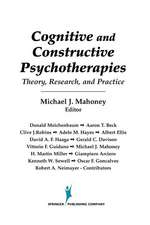Solution Focused Brief Therapy: 100 Key Points and Techniques: 100 Key Points
Autor Harvey Ratner, Evan George, Chris Ivesonen Limba Engleză Paperback – 24 mai 2012
- The history and background to solution focused practice
- The philosophical underpinnings of the approach
- Techniques and practices
- Specific applications to work with children and adolescents, (including school-based work) families, and adults
- How to deal with difficult situations
- Organisational applications including supervision, coaching and leadership.
- Frequently asked questions
| Toate formatele și edițiile | Preț | Express |
|---|---|---|
| Paperback (1) | 181.89 lei 3-5 săpt. | +10.76 lei 6-12 zile |
| Taylor & Francis – 24 mai 2012 | 181.89 lei 3-5 săpt. | +10.76 lei 6-12 zile |
| Hardback (1) | 969.78 lei 6-8 săpt. | |
| Taylor & Francis – 24 mai 2012 | 969.78 lei 6-8 săpt. |
Preț: 181.89 lei
Preț vechi: 191.47 lei
-5% Nou
Puncte Express: 273
Preț estimativ în valută:
34.80€ • 36.34$ • 28.81£
34.80€ • 36.34$ • 28.81£
Carte disponibilă
Livrare economică 14-28 martie
Livrare express 27 februarie-05 martie pentru 20.75 lei
Preluare comenzi: 021 569.72.76
Specificații
ISBN-13: 9780415606134
ISBN-10: 0415606136
Pagini: 272
Ilustrații: black & white illustrations
Dimensiuni: 129 x 198 x 18 mm
Greutate: 0.3 kg
Ediția:1
Editura: Taylor & Francis
Colecția Routledge
Seria 100 Key Points
Locul publicării:Oxford, United Kingdom
ISBN-10: 0415606136
Pagini: 272
Ilustrații: black & white illustrations
Dimensiuni: 129 x 198 x 18 mm
Greutate: 0.3 kg
Ediția:1
Editura: Taylor & Francis
Colecția Routledge
Seria 100 Key Points
Locul publicării:Oxford, United Kingdom
Public țintă
Postgraduate, Professional, and Professional Practice & DevelopmentRecenzii
"This book is a small treasure... By using short, easy-to-read chapters, the book explains their approach and covers some difficult ground in an approachable style... written as it is by three mature practitioners who first met the approach when it was a "new kid on the block", provides systemic practitioners with an opportunity to look again at an approach which is still very much around, well supported by evidence, appreciated by clients and now, as the authors might agree, also at a stage of significant maturity. We recommend it." - John Wheeler and Alex Millham, Context, October 2012
"“Do what works” is a basic SFBT rule. Were Steve and Insoo still with us, I am sure they would be very happy to see what their “students” have produced. Solution Focused Brief Therapy: 100 Key Points and Techniques is a clear exposition that embraces and builds on the original SFBT model. It also honors teachers, both de Shazer and Berg, and ultimately their clients, by applying de Shazer’s well- known Ockham ’s razor to explore and describe what is really essential for change to occur. To illustrate the principle: When someone once wrote the words “simplify, simplify, simplify” to describe SFBT’s minimalistic approach, de Shazer famously scratched out two of the words! Along with de Shazer’s 1985 Keys and 1988 Clues and Berg’s 1994 Family-Based Services, this book ranks at the top. As a place to start or as an elegant refresher, I enthusiastically recommend it!" - Michael F. Hoyt, Ph.D, Newsletter of the Milton H. Erickson Foundation, 2012, p. 24 VOL. 32, NO. 3 The Milton
"This book is a small treasure... By using short, easy-to-read chapters, the book explains their approach and covers some difficult ground in an approachable style... written as it is by three mature practitioners who first met the approach when it was a "new kid on the block", provides systemic practitioners with an opportunity to look again at an approach which is still very much around, well supported by evidence, appreciated by clients and now, as the authors might agree, also at a stage of significant maturity. We recommend it." - John Wheeler and Alex Millham, Context, October 2012
"“Do what works” is a basic SFBT rule. Were Steve and Insoo still with us, I am sure they would be very happy to see what their “students” have produced. Solution Focused Brief Therapy: 100 Key Points and Techniques is a clear exposition that embraces and builds on the original SFBT model. It also honors teachers, both de Shazer and Berg, and ultimately their clients, by applying de Shazer’s well- known Ockham ’s razor to explore and describe what is really essential for change to occur. To illustrate the principle: When someone once wrote the words “simplify, simplify, simplify” to describe SFBT’s minimalistic approach, de Shazer famously scratched out two of the words! Along with de Shazer’s 1985 Keys and 1988 Clues and Berg’s 1994 Family-Based Services, this book ranks at the top. As a place to start or as an elegant refresher, I enthusiastically recommend it!" - Michael F. Hoyt, Ph.D, Newsletter of the Milton H. Erickson Foundation, 2012, p. 24 VOL. 32, NO. 3 The Milton
"This book is a small treasure... By using short, easy-to-read chapters, the book explains their approach and covers some difficult ground in an approachable style... written as it is by three mature practitioners who first met the approach when it was a "new kid on the block", provides systemic practitioners with an opportunity to look again at an approach which is still very much around, well supported by evidence, appreciated by clients and now, as the authors might agree, also at a stage of significant maturity. We recommend it." - John Wheeler and Alex Millham, Context, October 2012
Notă biografică
Harvey Ratner, Evan George, Chris Iveson
Cuprins
Part I: Background. What is Solution Focused Brief Therapy (SFBT)? The Origins of SFBT (1): Milton Erickson. Origins (2): Family Therapy and the Brief Therapy Center at the Mental Research Institute in Palo Alto. Origins (3): The Brief Family Therapy Center (BFTC) in Milwaukee and the Birth of a New Approach. BFTC: The First Phase. BFTC: The Second Phase. SFBT Today. Philosophical Underpinnings: Constructivism. Philosophical Underpinnings: Wittgenstein, Language And Social Constructionism. Assumptions in SFBT. The Client-Therapist Relationship. The Evidence that SFBT Works. How Brief is Brief? Summary: The Structure of Solution Focused Sessions Part II: Features Of Solution Focused Interviewing. Ideas About Therapeutic Conversation. Choosing the Next Question. Acknowledgment and Possibility. Compliments. Deciding Who to Meet With Part III: Getting Started. Problem-Free Talk. Identifying Resources. Listening With a Constructive Ear: What The Client Can Do, Not What They Can’t. Constructive Histories. Pre-Meeting Change Part IV: Establishing A Contract. Finding Out the Client’s Best Hopes From the Work. The ‘Contract’: A Joint Project. The Difference Between Outcome and Process. The ‘Great Instead’. When the Client’s Hope is Beyond the Therapist’s Remit. When the Client Has Been Sent. Building a Contract With Young People. When the Client Says Don’t Know. When the Client’s Hopes Appear To Be Unrealistic. What if There is a Situation of Risk? When The Practitioner is a Gatekeeper to a Resource. What if We Fail to Develop a Joint Project? Part V: The Client’s Preferred Future. Preferred Futures: The Tomorrow Question. Distant Futures. Qualities of Well-Described Futures: The Client’s Perspective. Qualities of Well-Described Futures: Other Person Perspectives. Broadening and Detailing Part VI: When Has it Already Happened? Instances of Success. Exceptions. Instances of the Future Already Happening. Lists. No Instances, No Exceptions Part VII: Measuring Progress: Using Scale Questions. Scale Questions: The Evaluation of Progress. Designating The ‘0’ on the Scale. Different Scales. Successes in the Past. What is Good Enough? Moving Up the Scale. Signs or Steps. What if the Client Says They are at ‘0’? When the Client’s Rating Seems Unrealistic Part VIII: Coping Questions: When Times Are Tough. Handling Difficult Situations, Including Bereavement. Stopping Things From Getting Worse. Part IX: Ending Sessions. Thinking Pause. Acknowledgments and Appreciations. Making Suggestions. Making the Next Appointment Part X: Conducting Follow Up Sessions. What Is Better? Amplifying the Progress Made. Strategy Questions. Identity Questions. When the Client Says Things Are the Same. When the Client Says Things Are Worse Part XI: Ending the Work. Maintaining Progress. What if There is No Progress? Part XII: Assessment and Safeguarding. Assessment. Safeguarding Part XIII: Children, Families, Schools and Groupwork. Children. Adolescents. Family Work. Scales in Family Work. Couples Work. in the School. Schools: Individual Work. Schools: The WOWW Project. Groupwork Part XIV: Work With Adults. Homelessness. Alzheimer’s. Clients With Learning Difficulties. Substance Misuse. Mental Health. Trauma and Abuse Part XV Supervision, Coaching and Organisational Applications. Supervision. Team Supervision. Coaching. Mentoring. Team Coaching. Leadership Part XVI Frequently Asked Questions. Isn’t it Just a Positive Approach? Isn’t it Just Papering Over the Cracks? It Doesn’t Deal With Emotions. Isn’t SFBT Just a Strengths-Based Approach? What Account Does it Take Of Culture? Isn’t it Just a Form of Problem-Solving? It’s a Formulaic Approach Can it be Used With Other Approaches? Self-Help SFBT.
Descriere
This book provides a concise and jargon-free guide to the thinking and practice of this exciting approach, enabling people to make changes in their lives in the shortest possible time.





























